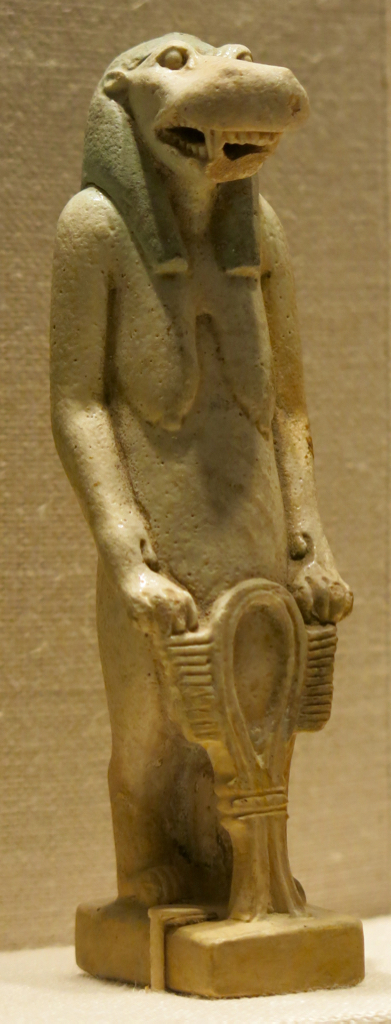Taweret is one of the deities who was a fairly common presence in ancient Egyptian households. Sculptures of Taweret have the head of a hippopotamus and the body of a female human being, and the arms and legs of a lion (note 1); though of course the physical manifestations of ancient Egyptian deities were not thought to adequately represent the actual deity. Sculptures of her “held the attribute of the sa [an ancient Egyptian symbol of magical protection] in her hands and sometimes also the ankh or a torch, the flame of which was supposed to expel typhonic forces” (note 2).
A statue of Taweret would typically stand in a niche in a house, with perhaps an offering table. A Taweret sculpture might also be placed in bedrooms, to prevent sleeping humans from being assaulted by demons or ghosts. According to some accounts, she was married to the god Seth (note 3).
Below is a fine tiny sculpture of Taweret, made of faience sometime in Dynasties 26-30, now in the Boston Museum of Fine Arts (accession number 64.2252). She is holding the sa, and you can see her hippo head, human body, and lion limbs. She is fearsome enough to give you a measure of assurance that she will indeed protect you, as a household god should; but she also appears friendly enough that I would not mind having her in my household.

Notes:
1. Garry J. Shaw, The Egyptian Myths: A Guide to the Ancient Gods and Legends (Thames and Hudson, 2014), p. 155.
2. Manfred Lurker, An Illustrated Dictionary of the Gods and Symbols of Ancient Egypt [Thames and Hudson, 1980/2006], English language edition of Gotter und Symbole der Alten Agypter, rev. and enlarged by Peter A. Clayton, p. 119.
3. Shaw, pp. 152, 158, 55.
